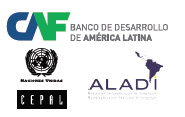Representatives from several international organizations and Latin American and Caribbean (LAC) Governments officially launch a Regional Energy Efficiency Programme.
The new Programme aims at producing a market and coherent pipeline for energy efficiency (EE) projects in LAC on both the supply and demand sides.
 12 September 2014: Representatives from several international organizations and Latin American and Caribbean (LAC) Governments officially launch a Regional Energy Efficiency Programme. The new Programme aims at producing a market and coherent pipeline for energy efficiency (EE) projects in LAC on both the supply and demand sides.
12 September 2014: Representatives from several international organizations and Latin American and Caribbean (LAC) Governments officially launch a Regional Energy Efficiency Programme. The new Programme aims at producing a market and coherent pipeline for energy efficiency (EE) projects in LAC on both the supply and demand sides.
The Programme, which was officially launched on 12 September 2014, at the headquarters of the Latin American Integration Association (ALADI) in Montevideo, Uruguay, was co-developed by ALADI, the Latin American Energy Organization (OLADE), the UN Economic Commission for Latin America and the Caribbean (ECLAC), the Organization of American States (OAS) (on behalf of the Energy and Climate Partnership for the Americas – ECPA), the World Energy Council’s LAC Network (WEC-LAC), the Regional Energy Integration Commission (CIER), and the Regional Association of the Oil, Gas and Biofuels sectors in Latin America and the Caribbean (ARPEL), with support from the Latin American Development Bank (CAF), as a follow-up to a 2013 joint study of regional energy development titled ‘Energy: A Vision on Challenges and Opportunities in Latin America and the Caribbean.’
The study identifies a number of barriers to successful deployment of EE technologies in the region, including: the absence of dedicated financial instruments; the need to aggregate similar small- and medium-scale projects to attract funding; the lack of guarantee funds to cover project risks; and the weakness or absence of EE normative entities and framework regulation.
Alfonso Blanco, Programme Coordinator, outlined the elements of the new Programme and the respective roles of the eight participating institutions. He explained that many of the initiatives under the Programme umbrella have already started separately under the various participating institutions, but would now be guided by a shared vision and coordinated as much as possible. Each institution will contribute according to its mandate and strengths. For example, CIER will work with electric power and hydrocarbon companies to identify EE opportunities on the supply side. ECLAC will develop: a baseline of EE indicators for the region; and a standard form for regional EE experts and Programme focal points to identify and register potential EE projects needing assistance. ECLAC will also advise governments in designing EE policies, and continue to host the annual regional political dialogue on EE.
The event also included a presentation by CAF on the Energy Efficiency Fund it created in 2013 together with the German development bank KfW to finance EE projects in the 16 LAC countries that are CAF stakeholders. As part of the Fund, an Energy Efficiency Technical Assistance Fund (FATEE), with an initial funding of US$2.9 million, will help identify and structure potential EE projects for CAF funding on the demand side. CAF also will provide US$0.3 million in non-reimbursable funds to help financial institutions in CAF member countries prepare EE financial instruments and train bank personnel in assessing and handling EE projects. [ALADI Release and Video of the Launch Event (in Spanish)] [Publication: Energy: A Vision on Challenges and Opportunities in Latin America and the Caribbean (in Spanish)]